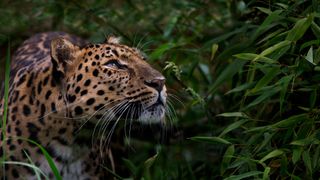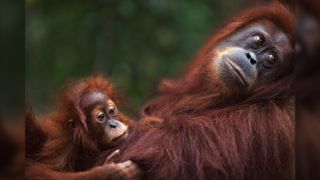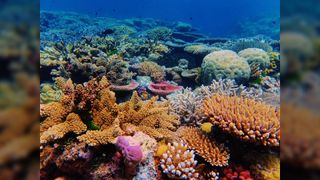
Which animals could go extinct by 2050?
Is there a list somewhere?

Five mass extinctions have happened in Earth's history, and numerous experts have warned that a sixth mass extinction could already be underway as a result of human activity since the Age of Exploration. Some scientists have even suggested that nearly 40% of the species currently residing on our planet could be extinct as early as 2050.
But is this just a worst-case scenario? Is such a dramatic decline in Earth's species likely to happen?
Related: Could climate change make humans go extinct?
A rising death toll
A sixth mass extinction is definitely plausible, said Nic Rawlence, director of the Otago Palaeogenetics Laboratory and senior lecturer in ancient DNA in the Department of Zoology at the University of Otago in New Zealand.
"I think it is quite likely," Rawlence told Live Science in an email. "And, if species don't go globally extinct, it's likely that those that can't adapt to our rapidly changing world will undergo range contractions, population bottlenecks, local extinctions, and become functionally extinct. The current extinction crisis may not have reached the height of the big five, but it's certainly on track if nothing is done to stop it."
According to the International Union for Conservation of Nature (IUCN) Red List of Threatened Species, around 41,000 — close to one-third of all assessed species — are currently threatened with extinction.
Many well-known species and subspecies — including the Sumatran orangutan (Pongo abelii), Amur leopard (Panthera pardus orientalis), Sumatran elephant (Elephas maximus sumatranus), black rhino (Diceros bicornis), hawksbill sea turtle (Eretmochelys imbricata), Sunda tiger (Panthera tigris sondaica) and Cross River gorilla (Gorilla gorilla diehli) — are classified as "critically endangered," meaning that they are at extremely high risk of extinction in the wild, according to both the IUCN and the World Wide Fund for Nature (WWF).
Sign up for the Live Science daily newsletter now
Get the world’s most fascinating discoveries delivered straight to your inbox.

IUCN describes critically endangered as "a category containing those species that possess an extremely high risk of extinction as a result of rapid population declines of 80 to more than 90 percent over the previous 10 years (or three generations), a current population size of fewer than 50 individuals, or other factors."
Many of these species are so severely threatened that they may not make it to 2050. For example, a mere 70 Amur leopards remain in the wild, while the vaquita (Phocoena sinus), a species of porpoise thought to be the world's rarest marine mammal, is down to only 10 individuals, according to the WWF.
There are countless lesser-known species that are also at risk. A 2019 review published in the journal Biological Conservation found that more than 40% of insect species are now threatened with extinction, with the researchers stating that "more sustainable, ecologically-based practices" need to be adopted across the board so as "to slow or reverse current trends, allow the recovery of declining insect populations, and safeguard the vital ecosystem services they provide."
Scores of insect species are on the IUCN's "critically endangered" list, including the white-tipped grasshopper (Chorthippus acroleucus), Southern Alpine Bush-cricket (Anonconotus apenninigenus), Swanepoel's blue butterfly (Lepidochrysops swanepoeli), Franklin's bumblebee (Bombus franklini) and the Seychelles wingless groundhopper (Procytettix fusiformis).
Related: What's the first species humans drove to extinction?
The same dire prediction of steep decline is present across nearly all life on Earth. According to a 2018 report by the Intergovernmental Panel on Climate Change (IPCC), more than 90% of the world's coral reefs could be dead by 2050 even if global warming is kept to 2.7 degrees Fahrenheit (1.5 degrees Celsius). A more recent IPCC report, however, was even more damning, suggesting that by the early 2030s, a 1.5 C global temperature rise could see "99% of the world's reefs experience heatwaves that are too frequent for them to recover."

According to a 2022 report published in the journal Nature, two in five amphibians (40.7%) are now threatened with extinction, while a 2016 report published by the journal Biology Letters has stated that, by 2050, 35% of frogs in the Wet Tropics of Queensland, Australia, "could be committed to extinction." In fact, the downfall of amphibians is likely to be even more pronounced. Scientists admit there are many amphibians they have struggled to gather detailed information about, and these species are categorized as data deficient (DD). According to a report published in 2022 in the journal Communications Biology, "85% of DD amphibians are likely to be threatened by extinction, as well as more than half of DD species in many other taxonomic groups, such as mammals and reptiles."
It is, therefore, incredibly difficult to determine the exact number of species that are likely to be extinct by 2050, largely because the scale of the extinction is still yet to be established. Moreover, we don't know how many species currently exist, which makes it all but impossible to determine all the creatures that are in danger.
That's partly because "taxonomy — the science of naming biodiversity — is critically underfunded," Rawlence said. "We cannot determine the number of species that go extinct if we can't name biodiversity (or name it fast enough before it goes extinct)."
While extinctions occur naturally — more than 99% of all species to ever exist have already gone extinct — human activity can dramatically speed up the rate of species extinction — an idea that hits close to home for Rawlence, a New Zealander.
"Island ecosystems are the perfect example to illustrate this," he said. "They are isolated and often contain high levels of endemicity (i.e., unique wildlife)." New Zealand has gone from about 230 bird species at the time of human arrival to about 150 species at present — a loss of around 80 species of birds, Rawlence said.
Related: How long do most species last before going extinct?
Many species can, if afforded time, adapt to climatic changes and alterations to their natural environment. A 2021 piece of research in the journal Trends in Ecology & Evolution found that some animals "are shifting their morphologies" to better cope with climate change, with some birds seeming to be the most adaptable. According to the research, several species of Australian parrots have, over the last 150 years, evolved to have an increased beak size, an adaptation which allows them to better regulate their internal temperature.
But, with human activity speeding up climate change and the decimation of habitats, some of the most vulnerable species are likely to bear the brunt and find themselves unable to adapt.
What can be done?
With so many species currently at risk of extinction, is there anything we can do to prevent the worst-case scenario?
For one, "the conflict between short-term political gain and long-term funding for conservation initiatives needs to be resolved," Rawlence said. "A lot of our endangered species are only surviving due to intensive conservation management. If governmental and public willpower, and resources, erodes, it will be a very different situation."
There are, of course, hosts of organizations, researchers and projects on a dedicated mission to slow, or even halt, human-related climate change. Climeworks, a company based in Switzerland, is a pioneer in the field of carbon dioxide air capture technology, and is aiming to build an array of facilities capable of removing CO2 from the air forever. Its first plant opened in Iceland in 2021.
Elsewhere, Project Drawdown, founded in 2014, is a nonprofit seeking to connect experts around the world so they can propose and trial concepts to stop greenhouse gases in the atmosphere from climbing, and will ultimately see them decline, while the Bill Gates-backed Stratospheric Controlled Perturbation Experiment is currently assessing the viability of spraying non-toxic calcium carbonate (CaCO3) dust into the atmosphere, in a bid to reflect sunlight and thereby offset — or significantly reduce — global warming's impacts.
In the meantime, we need to look to the past to inform the planet's future, Rawlence said.
"To save the biodiversity we have left, we need to know how it responded to past and present climatic change and human impact, so that we can predict how it might respond in the future underpinned by evidence-based conservation management strategies," he said.
In short, more research and hard work is required — before it's too late.
Originally published on Live Science.

Joe Phelan is a journalist based in London. His work has appeared in VICE, National Geographic, World Soccer and The Blizzard, and has been a guest on Times Radio. He is drawn to the weird, wonderful and under examined, as well as anything related to life in the Arctic Circle. He holds a bachelor's degree in journalism from the University of Chester.
